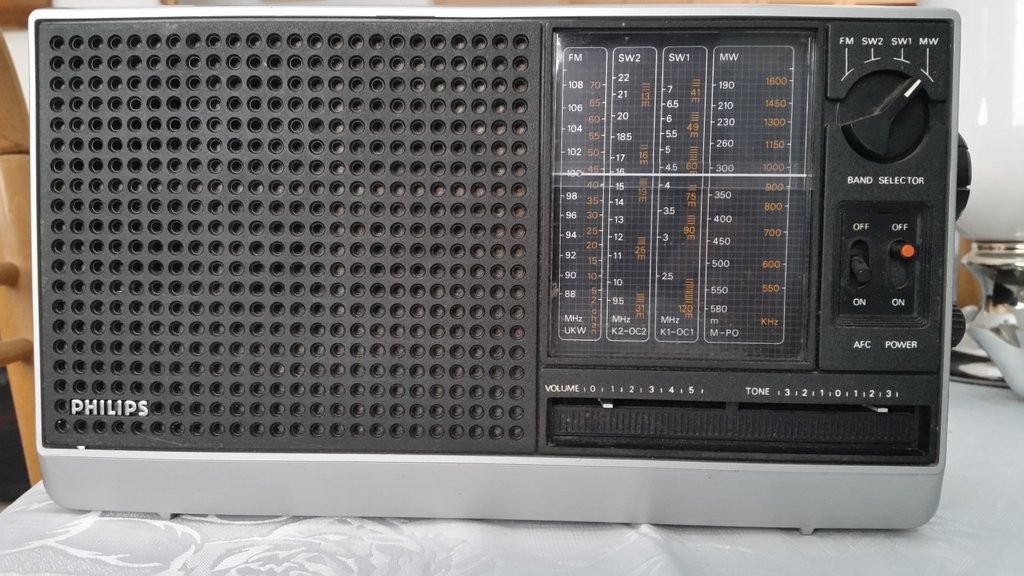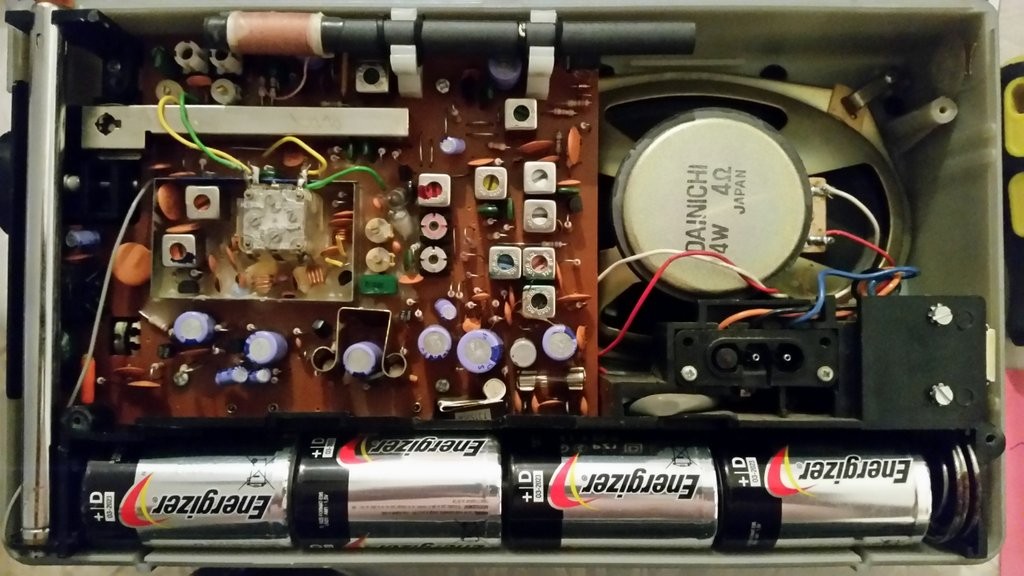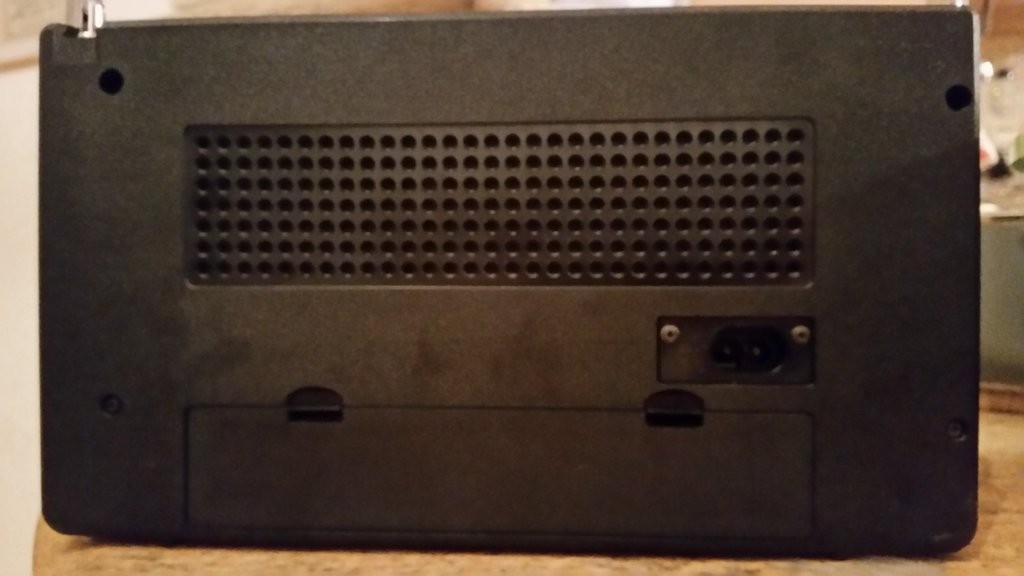 SWLing Post contributor, Moshe, writes:
SWLing Post contributor, Moshe, writes:
After reading your post about your Panasonic RF2200 pre-birthday present, I decided I want to do the same. The radio I chose has a story behind it…
My Grandfather had the same exact radio. I used to play around with the radio as a child, (especially with the shortwave bands, looking for number stations…). When my Grandfather died, about 23 years ago, the radio disappeared.
I decided this is the radio I want for my birthday. I could not remember the maker of the radio, nor it’s model, but I remembered how it looked.
I spent many days looking for all variations like “portable transistor radio” and so on, until I found a photo on the Internet: I was looking for a Philips 90AL765 radio.
I found it on Ebay. A very kind seller from Australia had it.
I purchased and receive the radio on the 26th of June (my birthday was the 12th of July). As soon as I got the radio, I opened it up; it needed cleaning (the case itself and the contacts).
After cleaning the contacts and washing the case, the radio runs (and looks) like new. I thought I would have to recap the radio, but it sounded perfect and without even a hint of hum, so I left it as it is.
It has the volume and tone knobs missing, but it can be operated with no problem. Sound quality is amazing (I added a video of the radio playing All India Radio on 6155 kHz)–it works very well on all bands and is very sensitive. By ear, the bandwidth sounds like 8 kHz or more. Radio bands are: MW, SW (2 bands) And FM.
The shortwave band is divided in two: SW1: 2.3MHz- ~7.4MHz, SW2: ~9.4MHz- 22.5MHz. For fine tuning on shortwave, the radio has a “Fine Tuning” control, which is a potentiometer connected to a varicap.
If you place the control in the middle (It lacks a detent spot) and tune in a station, this control will put you spot-on (the receiver is very stable).
Some info about the radio: According to Radiomuseum.org, the radio is dated to 1977, and was made in Austria (mine and my Grandfather’s were made in Singapore).
It contains 13 transistors, 3 of them are can transistors (not plastic).
Tuning is slide ruler type, and the only connection is A DIN5 for recording (wired for mono).
The radio can be operated from 4 D cells, or directly from AC (in the picture you can see the transformer). It can be operated from 230V or 120V. Note that if you move the plastic pin cover from the left pin to the right one, the center pin remains visible at all times. Also you will have to move the plastic cover piece on the back to the left.
The Ferrite is 14cm long, the telescopic antenna is 79cm fully extended, and it has an elbow joint that allows you to place the radio in your lap and still the antenna will point up with no problem. Only thing is that if the antenna is extended, the handle cannot change position since the antenna is in the way.
Width of the radio itself is 29cm (31cm with the handle and the knobs).
Depth is 7cm.
Height is 16.5cm (21cm with the handle).All in all, it is a very fine radio and I love it!
Moshe, thanks so much for sharing your story!
Perhaps, one of the true virtues of sites like eBay is that they allow us to search the world for somewhat obscure devices that have such a strong family and nostalgic connections. Congratulations on your find!



Hi Tomas,
It would be most interesting for me to see this radio. If I recall, Philips was a Dutch company, And I think that the reason for the Difference in Shortwave coverage was due to restrictions of the East European Block.
The Philips model numbers has a 2 digit designator to tell the coverage of the radio(90ALxxx/xx), mine is 45 which means that FM is up to 108MHz instead of 104MHz on other models, and Shortwave is as I described.
Best Regards,
Moshe.
Philips was and is a Dutch company, but they had foreign divisions and factories with some independence.
Here is a picture of the Dux 1780: http://www.ladda-upp.se/bilder/gukikaqwezer/
It obviously need some cleaning up… One of the differences is that it has the wavelength only in meters for the long wave and medium wave.
I think starting on 6 MHz is just a European thing, just like having station names on the dial. Even on custom versions for Sweden or other countries they start on 6 MHz (except on some radios that have a Fishing band starting with 1,8 MHz to around 4 MHz if I remember right). Older Swedish radios (including from Philips) has long wave support up to 400 kHz though, 300-400 kHz was used for “Lufor” which stands for Air Defense Orientation.
Best regards,
-Tomas
Seems nice, I have the Philips 90AL970 which is probably a “big brother” to this radio: http://www.radiomuseum.org/r/philips_970_90al97000_90_al_9700.html
In addition to the features of the 90AL765 the 90AL970 has longwave support, fine tuning for shortwave, separate bass and treble controls, dual speaker system, four FM presets and a switch for mute on/off whatever that is… It also has a 20 cm ferrite rod which makes it blow away all my other radios on mediumwave and longwave. It also has a tuning light. I don’t know if the shortwave performance is super exciting but the LW/MW performance certainly is.
Wow! indeed a rare find!
I just HAD to visit the link, and loved it!
There is another model: 90RL750 which looks like the 90AL765, it has LW also, and in addition it has PU (Pick Up) mode (to connect a record player) and only one Shortwave band which spans from 5.8MHz, to 16MHz.
But this radio takes it all. as for Shortwave reception, I can say that my 90AL765 has excellent reception compared to my Tecsun S2000, With lower noise floor.
Enjoy your radio!
Best Whishes,
Moshe.
Thanks!
The 90RL750 seems like the european version of your radio, all European radios in the 1970s had the PU connector (and had it since the 1950s atleast, probably even earlier).
Starting on 5.8 MHz also makes sense since the 49 meter band was called the “Europa band” and many German radios only covered 5.8 – 6.2 MHz or had a separate band which was this band only and then the other shortwave band was the bands above 49 meter. European shortwave basically never existed below 6 MHz and most radios didn’t cover it. The 90AL970 is the exception since it goes down to 2.3 MHz just like your radio, but my other Grundig and ITT/Shaub Lorenz transistor radios all start at just below 6 MHz, same with my Philips tube radio: http://www.radiomuseum.org/r/philips_b3x82u.html
I just bought a version of the Philips 90RL750 called DUX SX 1780/30. DUX was a Swedish radio manufacturer that was bought by Philips (In the 1930s or 1940s I think) and many Philips radios exist both as DUX and as Philips branded versions (but the radios were still made in Sweden as Philips had a Swedish division). Some of the DUX versions were more advanced than the Philips versions but many were the same. This radio is different from the Philips version and I don’t find any Philips radio with the model number 1780 (but for example my Philips 22RB444 exist as an identical DUX 22RB444 where only the logo is different).
The difference from the 90RL750 to the DUX 1780 is that the layout and buttons are different, they have round volume and tone controls (and the volume control turns on the radio). Also the AFC and band switch controls are different than the Philips version. The band coverage is the same (FM, MW, LW, SW) including PU and it has the same tuning and fine tuning controls on the side.
I just tried it briefly and the sound was very good and so was the FM and SW reception. It’s not on radiomuseum.org but I can take a picture and upload if anyone wants it.
Very heartwarming story of Moishe’s quest for a radio from his youth. Old radios bring us back to a time and place associated with happiness and good remembrances. Indeed it is a great age in which we live where we can find things from the past on the Internet for sale. Enjoy the radio and thanks for the great story Moishe.
Great story! Many different radios have a value that is not dependent solely on performance. History, design and nostalgia, as with Moshe, are also important.
Moshe,
I have this same radio, acquired last year I believe at a local estate sale for the sum of $5. It is a great radio! Enjoy.
–Neil, W2NDG
Hi Neil!
Indeed it is an excellent radio! as simple as the radio is, it preforms very well.
taking the radio outside makes most shortwave stations sound local.
I loved my grandfather’s radio as a child, and spent many hours with it (6y/o hooked by Numbers Stations…).
Best Regards,
Moshe.